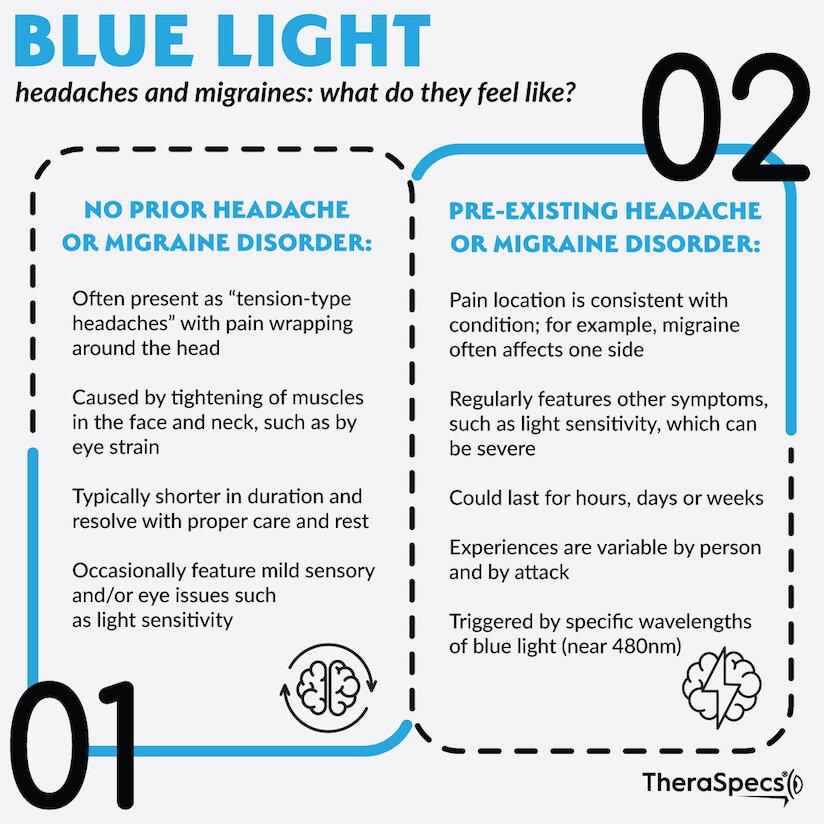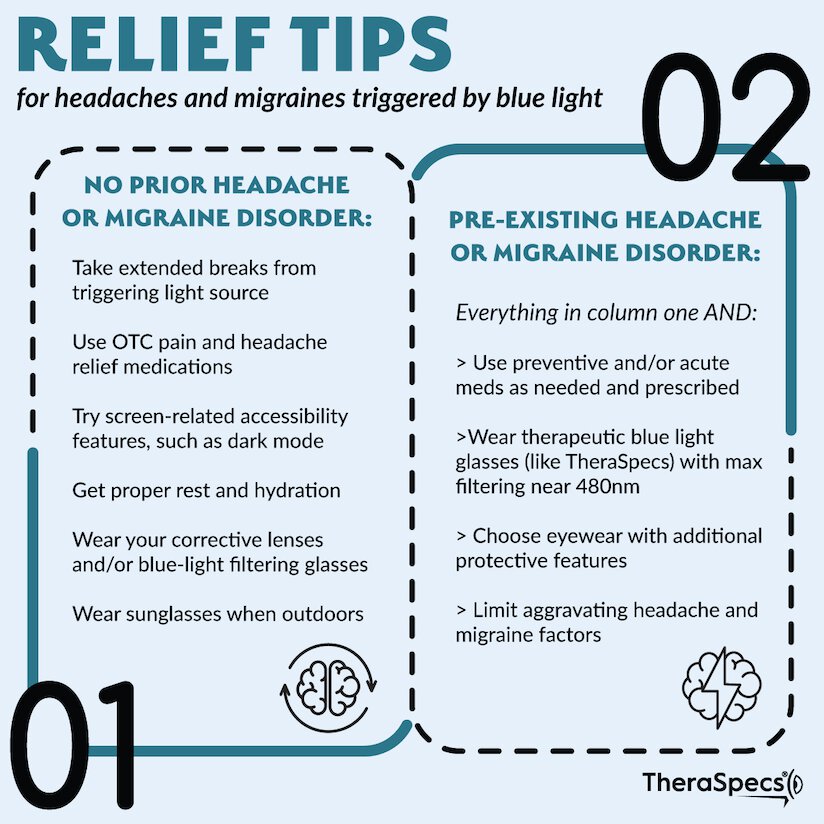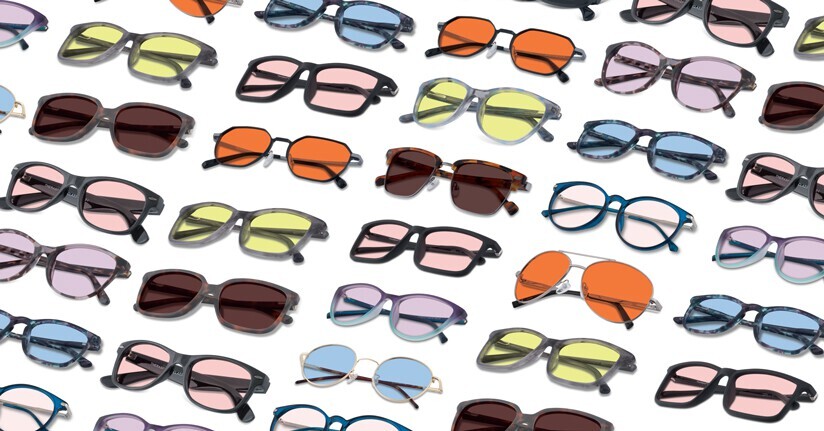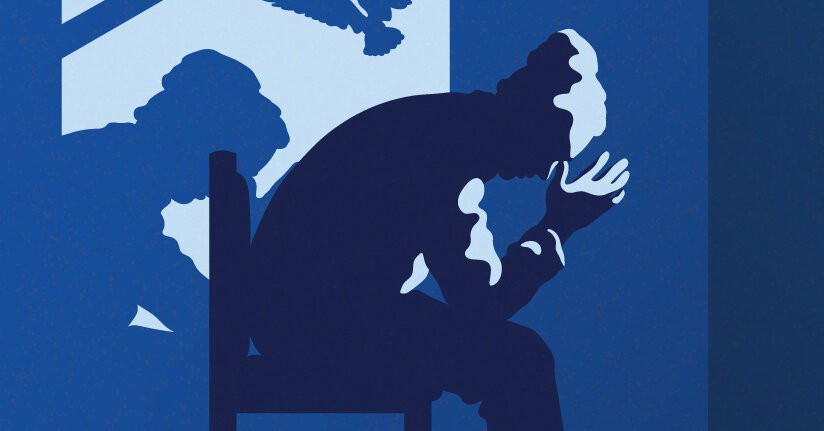Blue Light Headaches and Migraines: Causes, Experiences and Relief Options
Does looking at a smartphone screen or walking outside on a bright day initiate headache pain? Or have you been diagnosed with a type of migraine and find that light is bothersome? If so, then it may be the exposure to wavelengths of blue light that are the source of your symptoms, either directly or indirectly. Let’s take a closer look at the phenomenon of blue light-induced headaches and migraine attacks.
How Blue Light Causes Headaches and Migraine Attacks
There are several possible explanations for the impact of blue light on our eyes and brain. For a person with healthy eyes, blue light exposure from a variety of sources such as screens and sunlight can lead to eye strain, which often results in a constellation of symptoms like headaches. Longer duration of exposure and the brightness of the light source also play a role in the onset of headache symptoms.
Those who have migraine, or another primary light-sensitive headache disorder, have an entirely different confrontation with blue light. They tend to be hypersensitive to certain wavelengths of blue light near 480nm, which is further activated by neurological deficits in key pathways between the eye and brain. Thus, exposure to these wavelengths can trigger migraine attacks—which can include head pain and other symptoms of their condition.
Fluorescent lighting and some LEDs also uniquely affect people, with or without a prior headache or migraine disorder. Many of these sources emit an invisible pulsing that is processed in the brain, and this pulsing is most intense in the blue spectrum of light. This is why so many people can feel uneasy, in addition to having headaches and migraine attacks, when exposed to fluorescents.
What Blue Light-Induced Headaches and Migraines Feel Like
The physiological experiences associated with blue light headaches are primarily dictated by whether a person already has a condition that causes headaches, migraine attacks and/or light sensitivity.

For somebody without one of these disorders, they typically manifest as tension-type headaches—which feel like an achy pain that is located around the entire head. They are often the result of tightening of the muscles in the neck and face, which explains why eye strain (a common side effect of blue light exposure) can be a triggering factor for headaches. These headaches tend to be short in duration and resolve themselves within a few hours at most with proper care and rest. A person may have mild sensitivity to light and ocular symptoms (blurry vision, eye redness and pain, for example), but they are unlikely to persist for long periods of time.
For people with an established primary or secondary headache disorder, their symptoms more likely will reflect the characteristics of their condition. Headache pain associated with migraine without aura, for example, is often localized to one side; cluster headaches, on the other hand, typically affect one eye, either around or behind it.
There are also conditions that are not primary headache disorders, but that feature light-triggered head pain as a core symptom; COVID-19 and post-concussion syndrome are just two examples. And all of these conditions also feature a whole host of other physical complaints that can be brought on by blue light. This can include, but is not limited to: dizziness, vertigo, nausea, blurry vision, visual and nonvisual aura, muscle pain, facial and/or ocular pain, and more.
Unfortunately, a person with this ongoing hypersensitivity to blue light can endure symptomatic attacks for several hours or days. It is important to note, however, that headaches can present differently from attack to attack, so they may develop with differing levels of intensity, location, duration, additional symptoms, and other characteristics.
Relief for Blue Light Headaches

The strategies for relieving headaches and migraine attacks caused by blue light will also vary based on the presence of a preexisting light-sensitive disorder. If you do not any history of headache or photophobia, then you can:
- Take an extended break from the triggering light source
- Use over-the-counter pain and headache relief medications
- Try screen-related accessibility features, such as dark mode or color shift
- Take regular breaks to rest your eyes and brain while on your screen or exposed to other sources of blue light
- Get proper rest and hydration
- Wear your corrective lenses and/or blue-light filtering eyewear; TheraSpecs offers several lens tints that block different parts of the blue spectrum depending on the issue (e.g. for better sleep or to help improve visual sharpness)
- Wear sunglasses for blue light exposure when outdoors
If you have been diagnosed with a headache or migraine disorder, then you may want to take a more customized approach to your attacks initiated by blue light. In addition to the above recommendations, you also can:
- Use preventive meds as needed/prescribed and take acute medications at the onset of symptoms
- Wear therapeutic glasses from TheraSpecs that feature max filtering near 480nm and which also can help reduce the effects of fluorescent pulsing
- Choose therapeutic eyewear that offers additional protective features, such as wraparound frames and large direct coverage
- Limit aggravating headache and migraine factors, including other triggers and environmental stressors
Blue Light Blocking Glasses that Reduce Headaches and Migraines
You may have heard of so-called blue light glasses as an option to cut down on your exposure to the wavelengths that are causing your symptoms, but how effective are they? And are they all the same? The answer depends largely on the specific brand and their filtering capabilities.
It may be surprising to learn that most clear or nearly-clear glasses don’t actually block much blue light, despite their popularity. They primarily target blue wavelengths near UV light (400-420nm) and have an aesthetic appeal due to the lack of a noticeable tint, but they are unlikely to provide much benefit for people who have recurring and/or severe headaches and migraine attacks. Yellow-tinted computer or gaming-style glasses offer a little more protection throughout the blue spectrum of light, but they are most beneficial for helping with general vision and eye health—not for blocking the most harmful wavelengths that trigger migraines, photophobia, and/or headaches.

TheraSpecs are a unique brand of therapeutic glasses because they have several lens options that filter more across a wide range of harmful blue light, and that specifically maximize the amount of filtering near 480nm, unlike other products. As we mentioned, these are the wavelengths that lead to the most pain and other symptoms for people with photophobia. This makes TheraSpecs the best option for reducing headaches, migraine attacks, and light sensitivity associated with blue light exposure.
In a survey of light-sensitive persons, more than 70% of TheraSpecs users felt moderate, significant or total relief for their headaches and/or migraine attacks; only ~33% of these same individuals felt similar relief while using another brand(s) of blue light filtering glasses.
Even if you don’t have a light-sensitive condition, you can use TheraSpecs for those times where you need more sustained protection from your screen and/or fluorescents or LEDs. You can also explore their other lenses, many of which target blue light for a variety of needs.
More Reading: Light Sensitivity and Sources of Blue Light
Fluorescent Light Sensitivity: Causes, Symptoms and Solutions
Computer Screens: The Effect on Headaches, Migraines and Concussions
Why Does the Sun Give Me A Headache?
Related Reading: Blue Light Glasses
The BEST Blue Light Blocking Glasses for Migraine, Concussion and Light Sensitivity
Do Blue Light Glasses Help with Headaches, Migraines and Other Symptoms?
Do Blue Light Glasses Help with Fluorescent Lights?
Last updated 13th Mar 2024

TheraSpecs® Glasses for Light Sensitivity
Find the glasses that fit your needs and lifestyle, and stay protected from screens, fluorescents, unwanted blue light, sunlight, flashing lights, and more.
Shop Now



